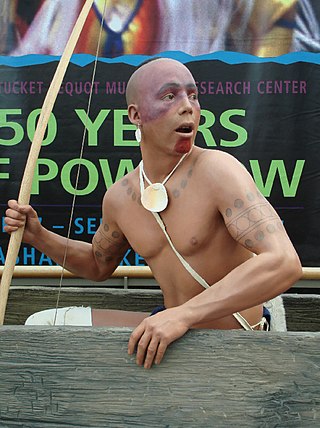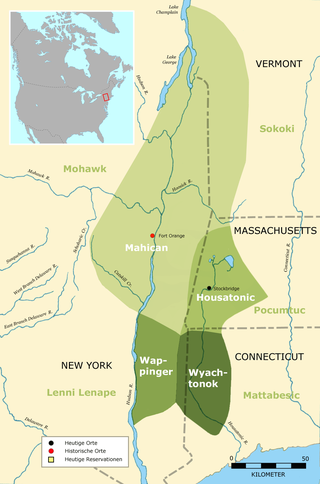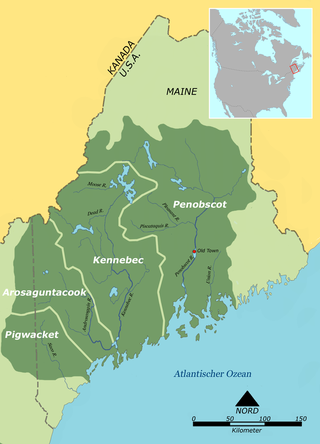
The Pequot are a Native American people of Connecticut. The modern Pequot are members of the federally recognized Mashantucket Pequot Tribe, four other state-recognized groups in Connecticut including the Eastern Pequot Tribal Nation, or the Brothertown Indians of Wisconsin. They historically spoke Pequot, a dialect of the Mohegan-Pequot language, which became extinct by the early 20th century. Some tribal members are undertaking revival efforts.
Uncasville is a village in the town of Montville, Connecticut, United States. It is located in southeastern Montville, at the mouth of the Oxoboxo River where it flows into the Thames River. The name is now applied more generally to all of the east end of Montville, which is the area served by the Uncasville ZIP Code (06382).

Miantonomoh, also spelled Miantonomo, Miantonomah or Miantonomi, was a chief of the Narragansett people of New England Indians.

Uncas was a sachem of the Mohegans who made the Mohegans the leading regional Indian tribe in lower Connecticut, through his alliance with the New England colonists against other Indian tribes.

The Quinnipiac were a historical Indigenous people of the Northeastern Woodlands. They lived in present-day New Haven County, Connecticut, along the Quinnipiac River. Their primary village, also called Quinnipiac, was where New Haven, Connecticut is today.

The Niantic are a tribe of Algonquian-speaking American Indians who lived in the area of Connecticut and Rhode Island during the early colonial period. They were divided into eastern and western groups due to intrusions by the more numerous and powerful Pequots. The Western Niantics were subject to the Pequots and lived just east of the mouth of the Connecticut River, while the Eastern Niantics became very close allies to the Narragansetts. It is likely that the name Nantucket is derived from the tribe's endonym, Nehantucket.

Wawyachtonoc were an Algonquian-speaking Native American people indigenous to east central New York and northwest Connecticut.
The Siwanoy were an Indigenous American band of Munsee-speaking people, who lived in Long Island Sound along the coasts of what are now The Bronx, Westchester County, New York, and Fairfield County, Connecticut. They were one of the western bands of the Wappinger Confederacy. By 1640, their territory (Wykagyl) extended from Hell Gate to Norwalk, Connecticut, and as far inland as White Plains; it became hotly contested between Dutch and English colonial interests.

The Pocomtuc were a Native American tribe historically inhabiting western areas of Massachusetts.
The Coree were a very small Native American tribe, who once occupied a coastal area south of the Neuse River in southeastern North Carolina in the area now covered by Carteret and Craven counties. Early 20th-century scholars were unsure of what language they spoke, but the coastal areas were mostly populated by Iroquois and Algonquian peoples.

The Occaneechi are Indigenous peoples of the Northeastern Woodlands whose historical territory was in the Piedmont region of present-day North Carolina and Virginia.
The Mohegan are an Algonquian Native American tribe historically based in present-day Connecticut. Today the majority of the people are associated with the Mohegan Indian Tribe, a federally recognized tribe living on a reservation in the eastern upper Thames River valley of south-central Connecticut. It is one of two federally recognized tribes in the state, the other being the Mashantucket Pequot, whose reservation is in Ledyard, Connecticut. There are also three state-recognized tribes: the Schaghticoke, Paugusett, and Eastern Pequot.
The Podunk were a Native American people who spoke an Algonquian Quiripi language and lived primarily in what is now known as Hartford County, Connecticut, United States. English colonists adopted use of a Nipmuc dialect word for the territory of this people.

Fort Shantok, in Montville, Connecticut, United States, was the site of the principal Mohegan settlement between 1636 and 1682 and the sacred ground of Uncas, one of the most prominent and influential Mohegan leaders and statesmen of his era. Originally part of Mohegan reservation lands, the property was taken by the state of Connecticut in the 20th century and Fort Shantok State Park was established. In 1995, following legal action by the tribe to recover its lands, the state returned the park to Mohegan control. The tribe now operates the area, part of its reservation, as a local park. The grounds were declared a National Historic Landmark in 1993.

The Androscoggin (Ammoscocongon) were an Abenaki people from what are now the U.S. states of Maine and New Hampshire. By the 18th century, they were absorbed by neighboring tribes.

The Bidai, who referred to themselves as the Quasmigdo, were a tribe of American Indians from eastern Texas.

Mohegan Indians v. Connecticut (1705–1773) was the first indigenous land rights litigation in history in a common law jurisdiction. James Youngblood Henderson, professor of law, calls the case "the first major legal test of indigenous tenure." Robert Clinton calls it the "first formal litigation of North American Indian rights."

The Mohegan Tribe is a federally recognized tribe and sovereign tribal nation of the Mohegan people. Their reservation is the Mohegan Indian Reservation, located on the Thames River in Uncasville, Connecticut.
The Accomac people were a historic Native American tribe in Accomack and Northampton counties in Virginia. They were loosely affiliated with the Powhatan Confederacy.
Pocasset was a former Wampanoag settlement, located between present-day Tiverton in Newport County, Rhode Island, and Fall River in Bristol County, Massachusetts. Pocasset is also the band of Wampanoag who lived in the settlement.











